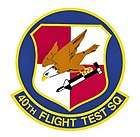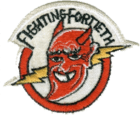40th Flight Test Squadron
| 40th Flight Test Squadron | |
|---|---|
|
USAF F-16A block 15 #80-573 from the 3247th TS armed with an AIM-9 Sidewinder missile and a cluster weapon in flight on 12 May 1986. Aircraft now on display at USAF Armament Museum, Eglin AFB | |
| Active | 1940--present |
| Country | United States |
| Branch | Air Force |
| Role | Flight Testing |
| Insignia | |
| 40th Flight Test Squadron emblem |
 |
| Patch with 40th Fighter-Interceptor Squadron emblem (approved 9 July 1959)[1] |
 |
| 40th Pursuit Squadron emblem (approved 19 June 1941) |
 |

40th Fighter-Interceptor Squadron Convair TF-102A-45-CO Delta Dagger 56-2360, Johnson AB, Japan, 1963
The 40th Flight Test Squadron is a United States Air Force unit. It is assigned to the 46th Operations Group, based at Eglin Air Force Base, Florida.
Lineage
- Constituted 40th Pursuit Squadron (Interceptor) on 22 December 1939
- Activated on 1 February 1940
- Redesignated: 40th Fighter Squadron on 15 May 1942
- Redesignated: 40th Fighter Squadron, Single Engine, on 20 August 1943
- Redesignated: 40th Fighter-Interceptor Squadron on 20 January 1950
- Redesignated: 40th Tactical Fighter Squadron on 20 June 1965
- Inactivated on 15 October 1970
- Activated on 1 October 1971
- Inactivated on 30 April 1982
- Consolidated (1 October 1992) with the 3247th Test Squadron, which was designated, and activated, on 25 June 1982.
- Redesignated: 40th Test Squadron on 1 October 1992
- Redesignated: 40th Flight Test Squadron on 15 March 1994.
Assignments
- 31st Pursuit Group, 1 February 1940
- 35th Pursuit (later, 35th Fighter; 35th Fighter-Interceptor) Group, 15 January 1942
- Attached to 35th Fighter-Interceptor Wing, 15 January – 14 July 1954 and 8 October 1956 – 1 July 1957
- 41st Air Division, 1 October 1957
- Attached to 3d Bombardment Wing, 1 December 1961 – 31 May 1962
- Tactical Air Command, c. 17 June 1965
- 33d Tactical Fighter Wing, 20 June 1965 – 15 October 1970
- 355th Tactical Fighter Wing, 1 October 1971 - 1 June 1972
- 35th Tactical Fighter Wing, 1 June 1972 – 30 April 1982
- 3246th Test Wing, 25 June 1982
- 46th Test Wing, 1 October 1992
- 46th Operations Group, 8 September 1993 – present
Stations
Aircraft
- P-39 Airacobra, 1941–1944
- P-47 Thunderbolt, 1944–1945
- P(later F)-51 Mustang, 1945–1950, 1950–1953
- F-80 Shooting Star, 1950, 1953–1954
- F-86D Sabre Interceptor, 1953–1961
- F-102 Delta Dagger, 1960–1965
- F-4 Phantom II 1965–1969
- A-7 Corsair II, 1971–1972
- Conducted test and evaluation missions, using the following aircraft, A-10, F-4, F-15, F-16, F-111, T-38, T-39, C-130, CV-22, and UH-1, 1982–present
Operational history
Combat in Southwest and Western Pacific, 2 June 1942 – 14 August 1945. Served in the occupation force in Japan, 1945–1950. Combat in Korea, 8 July 1950 – 25 May 1951. Air defense in Japan and Korea, June 1951 – June 1965. Trained cadres for transfer to Southeast Asia, 1966–1969. Not manned, 10 May 1969 – 15 October 1970 and 1 June 1972 – 30 April 1982.
See also
References
![]() This article incorporates public domain material from the Air Force Historical Research Agency website http://www.afhra.af.mil/.
This article incorporates public domain material from the Air Force Historical Research Agency website http://www.afhra.af.mil/.
- ↑ Maurer, Combat Squadrons, p. 187-188
- Maurer, Maurer, ed. (1983) [1961]. Air Force Combat Units of World War II (PDF) (reprint ed.). Washington, DC: Office of Air Force History. ISBN 0-912799-02-1. LCCN 61060979.
- Maurer, Maurer, ed. (1982) [1969]. Combat Squadrons of the Air Force, World War II (PDF) (reprint ed.). Washington, DC: Office of Air Force History. ISBN 0-405-12194-6. LCCN 70605402. OCLC 72556.
This article is issued from
Wikipedia.
The text is licensed under Creative Commons - Attribution - Sharealike.
Additional terms may apply for the media files.




.svg.png)